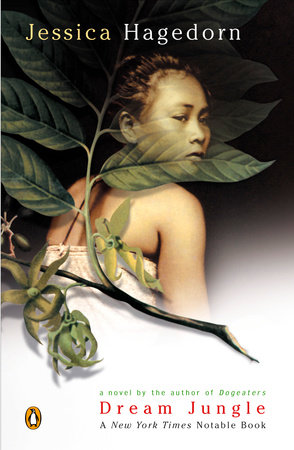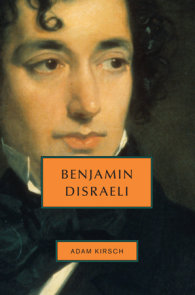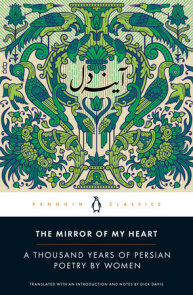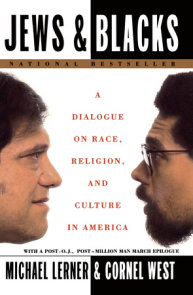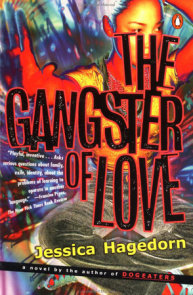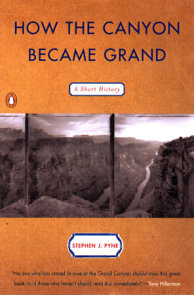READERS GUIDE
Questions and Topics for Discussion
INTRODUCTION
In her riveting new novel, Dream Jungle, Jessica Hagedorn takes us to the Philippines of the 1970s and spins an extraordinary, epic tale that is inspired by two real-life events: the supposed discovery of a primitive tribe, the Tasaday, deep in the rain forest—a discovery later alleged to be a hoax—and the filming of Apocalypse Now, a war movie foolishly filmed in a war zone with a vast and unpredictable cast and crew. Shifting between accents and dialects, between slang and philosophical reverie, Hagedorn channels the unique voices of dozens of characters with pitch-perfect accuracy, weaving them into a complex tapestry: a portrait of a country in flux.
For Hagedorn’s characters, the dream of the Philippines proves to be one of fantasy and delusion rather than the realization of paradise. Zamora Lopez de Legazpi is a wealthy playboy and dilettante, accustomed to freely exercising his power, who briefly finds meaning and self-worth in the discovery of a lost stone-age tribe called the Taobo. Upon seeing them, the jaded millionaire feels that “He had walked into a dream. . . . Everything he saw and heard filled him with love” (p. 5). The Taobo, and a young boy named Bodabil in particular, tap into his desire to be admired and accomplished. But is Zamora being tricked, fed what he wants to know by underlings desperate to please a rich man? Zamora owns a mansion in Manila, through which travel a host of confused and compromised characters, including his German wife, Ilse, and his cook, Candelaria, mother of the young beauty Rizalina. Rizalina is the only survivor of a shipwreck that drowns her good-for-nothing father and twin brothers, a survivor with a feisty spirit and a keen mind. A strange bond develops between the precocious Rizalina and the bored Zamora, one that will enrich her life but that will also force her to choose between her mother and her own well being, even as Zamora spirals downward into boredom and self-doubt.
Later in the same decade, another man trying to bring a fantasy to life arrives in the Philippines: Tony Pierce, the egomaniacal director of Napalm Sunset. The filming of this sometimes comic and sometimes disturbing send-up ofApocalypse Now involves a host of variously imbalanced characters, including Vincent Moody, an unhappy child actor grown into a decadent young man yearning for escape. Moody falls in love with Rizalina, now working in the seedy streets of Manila, and their attempt to achieve a workable love drives the second half of the novel. Paz Marlowe, a Filipina journalist transplanted to Los Angeles by a now failed marriage, returns to the country for her mother’s funeral and stays to pursue both stories: that of Zamora and his now discredited Taobo and that of the Hollywood production in the process of self-destruction near the banks of Lake Ramayyah. Working for a sensationalist magazine, she hunts for answers to the riddle of Zamora’s discovery and the motivation for Tony Pierce’s out-of-control, potentially brilliant film. Together with her friend, an aspiring director himself, and the contacts of her artistic family, Paz provides a modern Filipina heart to the last half of the novel; through her, Hagedorn leads the reader deep into the soul of the Philippines.
Jessica Hagedorn uses her remarkable talent to inhabit the life of this beautiful country, using an astoundingly wide array of voices to explore the after-affects of colonialism and the repercussions of globalization. Evoking a transitional moment in a nation’s life, a decade teeming with corruption, populated by citizens striving for opportunity as modernity arrives in all its clamorous chaos, Dream Jungle demonstrates the cost of the abuse of power and the devastation that can be wrought by self-delusion. But it is also a novel about a country graced with exquisite natural beauty, and about people with the intelligence and wit to adapt quickly to the new worlds that press upon them. In prose that is both ethereal and refreshingly earthy, Hagedorn has written an epic of profound importance and gripping emotion.
ABOUT JESSICA HAGEDORN
Jessica Hagedorn is the author of the novels Dogeaters and The Gangster of Love, Dream Jungle, and a collection of poetry and short fiction, Danger and Beauty.
A CONVERSATION WITH JESSICA HAGEDORN
You present the Philippines of the ’70s as a country in transition—one struggling to assimilate and resolve multiple outside forces while under the hand of a corrupt ruling class. Can you talk a little more about this? How has the situation changed?
After the oppressive twenty-year rule of Ferdinand and Imelda Marcos, some elements of the situation in the Philippines have changed for the better. Civil liberties have been restored, and the press is free to publish whatever it wants. But the poor remain poorer than ever, the rich are the same old rich, the economy is in a bad way, the environment—particularly in urban areas—is polluted, the Catholic Church still has too much power, and most of the politicians are as flagrantly corrupt as they’ve always been.
The Taobo controversy you describe is based on a real hoax, involving the Tasaday. You went to the jungle to try to find the Tasaday; can you describe both the physical setting and the tribe itself? Had you ever been into the rain forest before? How did your own adventure affect your telling of the story?
The fictionalized Taobo controversy in my novel is based on an alleged hoax involving the Tasaday tribe—an actual tribe of people living in the mountainous jungles of Mindanao, in the southern Philippines. I don’t take sides on the issue of whether a hoax was perpetrated by the so-called “discoverer” of the tribe, Manuel Elizalde, Jr. (an inspiration for my own Zamora Lopez de Legazpi character) back in 1971. I think the story is a lot more complex than that, and there’s always a bit of truth to everything. Before writing Dream Jungle, I had never been to the area in Mindanao that is described in my novel. But a Guggenheim Fellowship allowed me to travel to the region in 2001 and do research. I ended up in Lake Sebu, Cotabato del Sur, which is lush, mountainous and incredibly beautiful. By sheer chance, Belayem, one of the surviving members of the original Tasaday tribe who met with Elizalde back in the ’70s, happened to be in the village market one morning. With the help of Maria Todi Wanan, my Tboli guide and translator, I interviewed Belayem and Dafal, the legendary guide who led Elizalde into the rain forest.
In Dream Jungle, do you deliberately leave the authenticity of Zamora’s Taobo in doubt? By doing so, are you suggesting that the boundaries of fantasy and reality are blurred?
Yes to both questions.
What inspired the idea of combining the Apocalypse Now/Napalm Sunset storyline with the drama about the Taobo? Can you talk about how they are related thematically?
Both events occurred in the ’70s, when it seemed anything was possible. The Vietnam War was still going on. The idea of combining the two storylines had to do with the themes of “discovery and conquest” which constitute Part One of the narrative, but really underscore my entire novel. Another parallel theme is cultural mythmaking. As legend goes, the filming ofApocalypse Now was a grueling, crazy process that had an impact on the Philippine landscape and on the filmmakers themselves. A conquistador like Magellan or the fictional Zamora has to be obsessed in order to do what he does. The same goes for a genius director like Coppola or my fictional Tony Pierce.
You also interviewed Manda Elizalde, the man who “discovered” the Tasaday. Tell us more about this fascinating twentieth-century figure and his place in Filipino history.
I don’t know if Elizalde has much of a place in Filipino history at the moment. He’s considered—by those who remember him—as more of a millionaire eccentric and a buffoon. The Tasaday event and Elizalde—once the objects of international media attention—are now largely ignored or forgotten, except maybe by a few bemused or pissed-off anthropologists . . . or curious writers like me.
You are actually very generous to the Zamora character; instead of merely condemning him as a decrepit colonial vestige, you write him as a man filled with unrequited longings, an almost tragic figure. How did this more complex character emerge for you? Were you tempted to be less sympathetic?
I love my characters and especially love my villains. As with most writers, I don’t like taking the easy road into creating a story or a character. All human beings are flawed, complex and filled with dreams and unrequited longings. I was never tempted to be less sympathetic.
You have some very strong passages depicting corruption during the Marcos regime, and characters like Tony Pierce and Zamora also exhibit signs of moral decay. Why did corruption become such a major theme of this novel?
I suppose my answer to this question is connected to my answer to the previous question. I am fascinated by dark subjects.
Unlike Zamora, a man trapped by his place in society, or Rizalina, a woman caught in circumstances beyond her control, Paz Marlowe is a very contemporary young woman: bicultural, a little alienated, but talented, ambitious, and modern. Can you talk more about why you think she leaves the Philippines, and what her future might look like as you imagine it?
Paz leaves the Philippines because she is somewhat ambitious and eager to explore the larger world. She is a hybrid creature—sometimes cursed, and often blessed by her situation.
Rizalina also ends up leaving the Philippines. Why do so many of your characters end up in the United States? By deliberately ending the novel with Pepito Ponce de Leon at work, are you trying to suggest anything about those who stay?
I don’t know why so many of my characters end up in the United States. Maybe because that’s what I observe happening all around me. Ending the novel with Pepito at work felt very organic. He is an artist who has chosen to stay in the Philippines and thrive.
You write in the voices of many characters in this book. How did you come to the decision to fragment the narrative in this way, and how does this strategy alter the scope and meaning of the novel?
I intended this novel to be epic. Writing in the voices of many characters and perspectives is something I do. This time, it felt really right.
As a well-known writer, has your own relationship to the Philippines, the country you were born in, changed in any way?
I have to keep explaining that I am simply one writer, among many. And that my views are mine, and do not represent an entire nation.
You live in New York now. Will your next work—in whichever of your many mediums!—deal with the Philippines again, or are you perhaps working on something set in the United States?
I am working on something set in New York City, which I am not sure is typical of the United States.
What writers or books have influenced you most deeply over the years? What are you reading now?
Gabriel Garc’a M‡rquez, Manuel Puig, Denis Johnson, Jorge Luis Borges, Robert Stone, Russell Banks, and Toni Morrison have affected me over the years. Marquez and Puig have been deeply influential. I’m reading Margaret Atwood’s The Blind Assassin at the moment. She’s brilliant . . . and I’m loving every minute of it! I am looking forward to reading the Turkish writer Orhan Pamuk next.
DISCUSSION QUESTIONS







